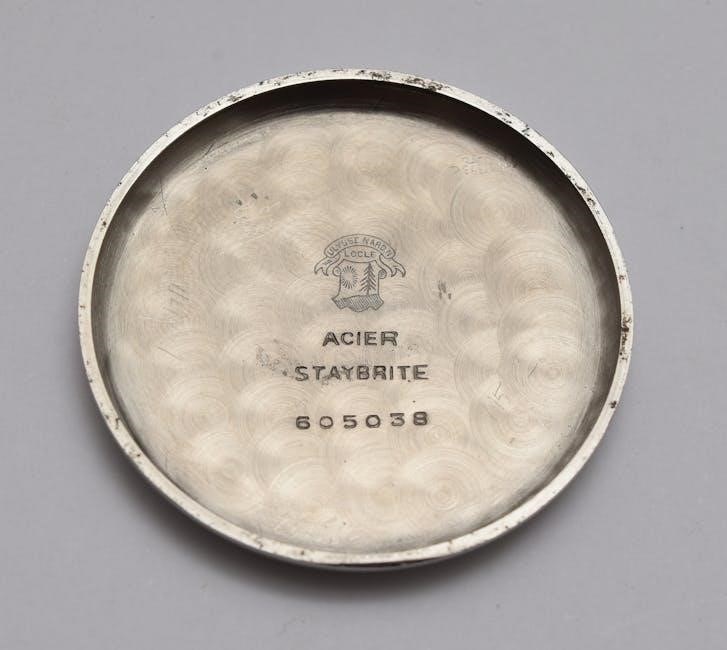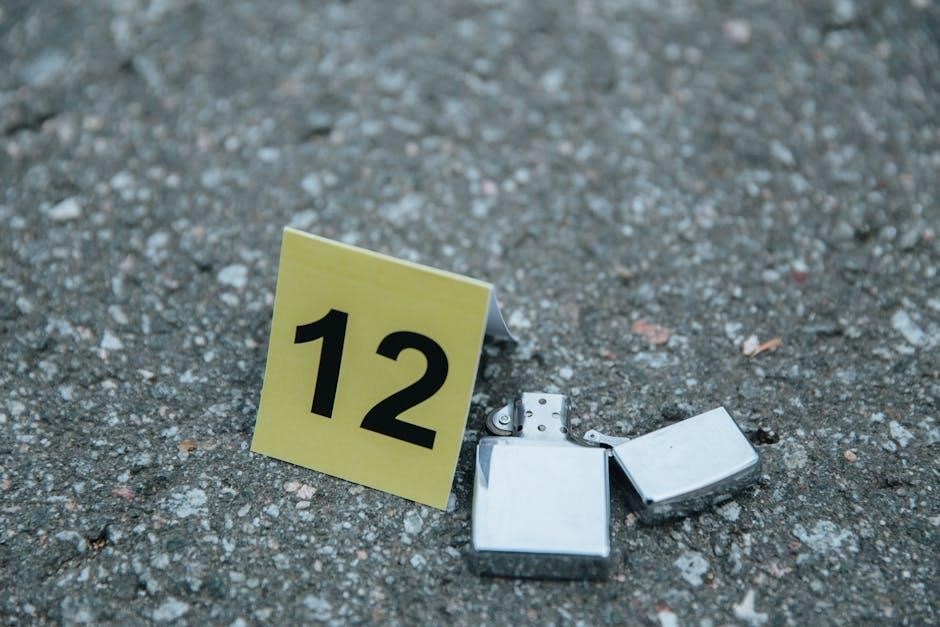Understanding your Case backhoe’s serial number is crucial for identifying its year of manufacture, model, and manufacturing details. This guide helps you decode these numbers effectively, ensuring accurate machine identification and maintenance.
1.1 Understanding the Importance of Serial Numbers
Serial numbers are unique identifiers for your Case backhoe, providing critical information about its manufacture year, model, and production details. They play a vital role in tracking, verifying, and authenticating machinery, ensuring compliance with regulatory standards. Knowing your serial number is essential for maintenance, repairs, and warranty claims, as it helps in identifying compatible parts and services. Additionally, serial numbers are crucial for determining the resale value of your backhoe, as they provide a clear record of its history and authenticity. Accurate identification through serial numbers also aids in compliance with legal and insurance requirements, making them indispensable for both owners and operators.
1.2 Overview of the Guide
This comprehensive guide is designed to help you decode and understand your Case backhoe’s serial number, unlocking essential information about your machine. It covers various aspects, including the structure of serial numbers for both older and newer models, methods to locate the serial number on your equipment, and a step-by-step process for decoding it. Additionally, the guide provides model-specific details, such as those for the Case 580B and 580K, and offers troubleshooting tips for common issues. By following this guide, you’ll gain the knowledge needed to identify your backhoe’s manufacturing year, model, and other critical details, ensuring proper maintenance and maximizing its performance and longevity.

Why Knowing Your Case Backhoe’s Year Matters
Knowing your Case backhoe’s year is essential for maintenance, repair planning, and ensuring warranty compliance. It also helps in determining resale value and optimizing machine performance.
2.1 Maintenance and Repair
Accurate knowledge of your Case backhoe’s year is vital for effective maintenance and repair. Different model years may require specific parts, tools, and service intervals. Older models (pre-2004) have 7-8 digit serial numbers, while newer models (2004-present) include the year as the second digit in their 9-10 digit serial numbers. This information helps technicians identify compatible components and ensures proper repair procedures. Additionally, understanding the manufacturing year allows owners to access model-specific manuals and resources, which are essential for DIY repairs and routine maintenance. Regular maintenance tailored to your machine’s age and model minimizes downtime and extends its lifespan, making it a critical aspect of equipment ownership and operation.
2.2 Warranty and Support
Knowing your Case backhoe’s year is essential for verifying warranty status and accessing manufacturer support. The serial number, particularly the second digit in newer models (2004-present), indicates the manufacturing year, helping determine if your machine is still under warranty. This information ensures you can claim repairs or replacements without additional costs. Additionally, understanding your backhoe’s age allows you to access model-specific support resources, such as manuals and service guides. Accurate identification also helps dealers verify eligibility for extended warranties or service programs, ensuring you receive the support needed to maintain your equipment effectively. This knowledge is crucial for optimizing your investment and ensuring uninterrupted operation.
2.4 Resale Value
Accurately identifying your Case backhoe’s year through its serial number can significantly impact its resale value. Knowing the exact model and age allows you to provide transparent information to potential buyers, enhancing trust and appeal. Older models, such as the 580B (1976-1980), may attract collectors or those seeking reliable, vintage equipment. Newer models (2004-present) with clear manufacturing dates often command higher prices due to advanced features and better condition. A well-documented history, verified by the serial number, can justify a higher asking price and attract more buyers. This transparency ensures a smoother selling process and maximizes your machine’s market value.

Understanding Case Backhoe Serial Number Structure
Case backhoe serial numbers vary by model year, with older models (1988-2003) using 7-8 digits and newer models (2004-present) using 9-10 digits, where the second digit indicates the year.
3.1 Older Models (1988-2003)
For Case backhoes manufactured between 1988 and 2003, the serial numbers typically consist of 7 to 8 digits. These older models do not explicitly include the year of manufacture within the serial number structure, making it necessary to refer to specific charts or guides to determine the production year. The serial numbers often start with a letter prefix, such as “C” or “D,” followed by a sequence of numbers. For example, a serial number like C1234567 would fall into this category. To decode these numbers accurately, owners and technicians must consult official Case documentation or serial number guides, which provide detailed correlations between serial number ranges and production years. This process ensures proper identification for maintenance, repairs, and parts ordering. Understanding the structure of these older serial numbers is essential for accurately determining the machine’s history and specifications. Additionally, these guides often include tables or charts that correlate serial number ranges with specific production years, which can be invaluable for identifying the exact model and year of older Case backhoes. By using these resources, users can unlock critical information about their equipment, ensuring optimal performance and compliance with maintenance schedules. Accurate identification of older models also aids in sourcing compatible parts and accessories, which may no longer be in production. Overall, decoding older Case backhoe serial numbers requires careful analysis and reference to official guides to ensure accurate results.
3.2 Newer Models (2004-Present)
Case backhoes manufactured from 2004 onwards feature serial numbers that are 9 to 10 digits long. A key distinction in newer models is the inclusion of the manufacturing year as the second digit in the serial number. For example, a serial number like N5C388221 indicates that the backhoe was produced in 2005, with “5” representing the year. This structured format simplifies the process of identifying the machine’s age and model. The extended length of the serial number also provides more detailed information about the equipment, such as the production series and specific features. By referencing official Case guides or charts, users can decipher the entire serial number to unlock insights into the backhoe’s specifications, production details, and maintenance history. This system enhances accuracy and efficiency for owners, technicians, and dealers, ensuring that repairs and parts ordering are handled correctly. The inclusion of the year in the serial number streamlines the identification process, making it easier to determine the appropriate maintenance schedules and warranty information. Additionally, this standardized approach helps in tracking the equipment’s lifecycle, from production to retirement, which is crucial for resale value and operational planning. Overall, the serial number structure for newer Case backhoes offers a comprehensive and accessible way to understand the machine’s background and requirements. This has proven to be a significant improvement over older models, where the year was not explicitly encoded, and decoding required more extensive research. By leveraging this structured format, users can make informed decisions about their equipment, ensuring optimal performance and longevity. The clarity provided by these newer serial numbers also aids in compliance with manufacturer recommendations, which is essential for maintaining warranty validity and ensuring safety standards. Furthermore, this system supports better inventory management for dealerships and service centers, allowing them to quickly identify and address customer needs. In summary, the serial number structure of newer Case backhoes is a valuable tool for anyone involved in the ownership, maintenance, or operation of these machines.

Locating the Serial Number on Your Case Backhoe
The serial number is typically found on the frame rail, often on the left side, or under the left door. Check carefully, as it may be obscured by paint or dirt. For newer models, it might also be located on the loader frame or near the operator’s seat. Ensure you locate the correct plate, as some models may have multiple identification tags. Referencing your owner’s manual or contacting a Case dealer can provide additional guidance if needed.
4.1 Older Models
For older Case backhoe models (1988-2003), the serial number is typically located on the left side of the dash, just inside the left door of the cab. It may also be found under the base of the left lift arm or on the frame rail. On some models, the serial number plate is located near the instrument panel or on the toolbox. Over time, the plate may become obscured by paint or dirt, so careful inspection is necessary. Be sure to distinguish it from the ROPS plate inside the cab, as this is not the VIN or serial number. Checking multiple locations ensures you find the correct identification for your machine.
4.2 Newer Models
For newer Case backhoe models (2004-present), the serial number is typically located under the left door on the frame rail or on the left loader frame. It may also be found on the underside of the left lift arm. The serial number plate is usually more accessible on these models compared to older ones. Newer models feature a 9-10 digit serial number, with the second digit indicating the year of manufacture. This standardized format makes it easier to identify the machine’s production details. Ensure the area is clean and free of debris for clear visibility. Referencing the serial number is essential for maintenance, repairs, and verifying the machine’s history. Always consult the official Case guide for accurate decoding.

Step-by-Step Guide to Decoding Your Serial Number
Start by identifying the serial number structure, focusing on the digit indicating the year of manufacture. For newer models, the second digit represents the year. Refer to the official Case guide for accurate decoding.
5.1 Identifying the Year of Manufacture
Identifying the year of manufacture for a Case backhoe involves analyzing the serial number. For models produced from 2004 onwards, the second digit of the serial number represents the year. For example, a serial number starting with “N5” indicates the machine was manufactured in 2005. Older models (1988-2003) require referencing a detailed serial number chart, as their serial numbers do not embed the year directly. By using the official Case backhoe serial number guide, you can accurately determine the production year, which is essential for maintenance, repairs, and warranty claims.
5.2 Determining the Model
Determining the model of your Case backhoe involves analyzing the structure of its serial number. For older models (1988-2003), the serial number does not directly indicate the model, requiring consultation of a detailed Case backhoe serial number guide. Newer models (2004-present) incorporate more detailed information, with specific prefixes or suffixes that correspond to particular models, such as the Case 580B or 580K. By cross-referencing the serial number with the official guide, you can accurately identify the model, which is essential for ordering parts, maintenance, and ensuring compatibility with attachments. This step ensures you have precise information about your machine, aiding in proper care and operation.

Model-Specific Serial Number Guides
Model-specific guides provide detailed serial number ranges for identifying Case backhoe models like the 580B and 580K, ensuring accurate identification for maintenance and repairs.
6.1 Case 580B
The Case 580B serial numbers typically start with a letter prefix, such as C or D, followed by a series of numbers (e.g., C1234567). These prefixes help identify the production era, with specific ranges correlating to manufacturing years. For instance, serial numbers for the 580B can be cross-referenced with charts to determine the exact year of production, enabling owners to pinpoint when their machine was built. This information is crucial for maintenance, repairs, and ensuring compatibility with parts.
Understanding the 580B serial number structure is essential for owners and operators. It not only aids in identifying the model but also provides insights into its history and specifications. Accurate identification ensures proper servicing and adherence to warranty terms, making it a vital step in machine ownership. Consulting the official Case 580B serial number guide is recommended for detailed breakdowns and verification. This guide offers a comprehensive overview, helping users unlock the full potential of their equipment.
6.2 Case 580K
The Case 580K serial number structure follows a specific pattern, particularly for models manufactured from 2004 onward. These serial numbers typically consist of 9-10 digits, with the second digit indicating the year of manufacture. For example, a serial number starting with “N5” would correspond to a machine built in 2005. This system allows owners to quickly identify their backhoe’s production year. The serial number for the 580K can usually be found on the left side of the frame rail or under the base of the left lift arm. Accurate identification is crucial for maintenance, repairs, and ensuring compatibility with parts. Consulting the official Case 580K serial number guide provides detailed breakdowns and verification, helping users optimize their equipment’s performance and longevity. This guide is an essential resource for owners seeking precise information about their machine.
6.3 Other Models
Beyond the 580B and 580K, other Case backhoe models like the 480, 570L, 580E, 590L, 680, and 680C have unique serial number structures. These models, especially those from 2004 onward, feature 9-10 digit serial numbers with the year embedded as the second digit. Older models (1988-2003) typically have 7-8 digit serial numbers. The serial number location varies across models; for instance, older models may have it under the left door or on the frame rail. Each model’s serial number guide provides specific details, such as prefixes and digit positions, to identify the year and other specifications. This ensures accurate identification and maintenance for owners of these less commonly discussed models. Consulting the appropriate guide is essential for decoding and understanding their serial numbers.
Using the Case Backhoe Serial Number PDF Guide
The Case Backhoe Serial Number PDF Guide provides a comprehensive resource for identifying and decoding serial numbers, helping users determine the year of manufacture and model specifics. It offers detailed tables, charts, and instructions to ensure accurate decoding, making it an essential tool for maintenance, repairs, and understanding your machine’s history.
7.1 Benefits of the PDF Guide
The Case Backhoe Serial Number PDF Guide offers numerous benefits, including quick access to serial number decoding, detailed model identification, and manufacturing year determination. It provides comprehensive tables and charts that correlate serial numbers with production years, making it easier to identify when your machine was made. Additionally, the guide helps with maintenance scheduling, warranty verification, and parts ordering by ensuring accurate information about your backhoe. Its user-friendly format allows owners and operators to navigate effortlessly, while the in-depth details empower users with valuable insights into their equipment’s history and specifications. This resource is indispensable for optimal machine performance and informed decision-making.
7.2 How to Use the Guide Effectively
To maximize the benefits of the Case Backhoe Serial Number PDF Guide, start by locating your machine’s serial number, typically found on the frame rail or instrument panel. Once identified, refer to the guide’s serial number structure section to understand the format. Next, use the year determination charts to decode the manufacturing year, often embedded in specific digits. For older models (1988-2003), focus on the 7-8 digit format, while newer models (2004-present) use 9-10 digits with the year as the second digit. Cross-reference this information with the model-specific sections to ensure accuracy. Regularly update your knowledge with the latest guide versions to stay informed about any changes in serial number conventions. By following these steps, you can efficiently unlock critical details about your Case backhoe.

Common Mistakes to Avoid When Decoding
When decoding your Case backhoe serial number, avoid common pitfalls to ensure accuracy. A frequent error is misidentifying the serial number location, such as confusing it with the engine or attachment numbers. Always verify the correct position, as older models (1988-2003) have serial numbers on the frame rail, while newer models (2004-present) often place them on the instrument panel. Another mistake is misinterpreting the digits, especially in older models with shorter serial numbers. Additionally, some users confuse the serial number with the ROPS plate or VIN number. To prevent errors, cross-reference your findings with official Case backhoe serial number charts and double-check the format for your machine’s production range. Avoid rushing the process, as small oversights can lead to incorrect year or model identification.

Troubleshooting Tips for Serial Number Issues
If you’re having trouble locating or decoding your Case backhoe serial number, start by ensuring you’re checking the correct location. Older models often have serial numbers on the frame rail or under the left lift arm, while newer models may have them on the instrument panel. Clean the area to remove dirt or paint that might obscure the number. If the serial number is illegible, consult a Case backhoe serial number guide for alternative methods. Avoid confusing the serial number with the engine or attachment numbers, as these are separate. Double-check your findings against official Case charts to confirm accuracy. If issues persist, contact Case support or a certified dealer for assistance.

Understanding the Manufacturing Date
The manufacturing date of your Case backhoe is a critical piece of information for maintenance, warranty, and operational planning. This date is often encoded within the serial number, typically found in specific digits or characters. For models produced from 1988 to 2003, the serial number is 7-8 digits long, while newer models from 2004 onwards use a 9-10 digit format, with the second digit indicating the year of manufacture. By decoding this information, you can accurately determine when your machine was built, ensuring compliance with maintenance schedules and warranty claims. Always refer to the official Case backhoe serial number guide for precise decoding instructions to avoid errors in identifying the manufacturing date.
The Importance of Accurate Identification
Accurate identification of your Case backhoe through its serial number is essential for ensuring proper maintenance, repairs, and compliance with manufacturer guidelines. Correct identification allows you to access the right parts, manuals, and support, preventing potential safety risks and equipment downtime. It also plays a key role in determining the machine’s value for resale or insurance purposes. Misidentification can lead to incorrect parts ordering and inefficient servicing, which may void warranties or compromise performance. By using the Case backhoe serial number guide, you can confidently identify your machine’s specifics, ensuring optimal functionality and longevity. This step is vital for both individual owners and fleet managers to maintain operational efficiency and uphold equipment integrity.

Additional Resources for Further Assistance
For comprehensive support, Case offers various resources to help with serial number interpretation and machine-specific details. The official Case website provides downloadable PDF guides, repair manuals, and parts catalogs. Additionally, authorized Case dealers can assist with detailed inquiries, offering expert advice and access to exclusive databases. Online forums and communities dedicated to heavy machinery also serve as valuable platforms for sharing knowledge and troubleshooting. For historical data, reaching out to Case IH archives or libraries specializing in agricultural equipment can provide additional insights. Leveraging these resources ensures you have all the necessary tools to maintain and optimize your Case backhoe effectively, addressing any challenges with precision and confidence.

